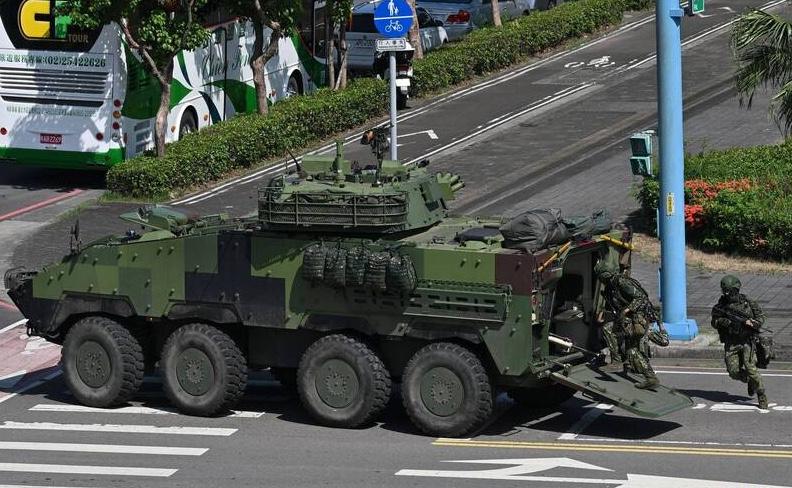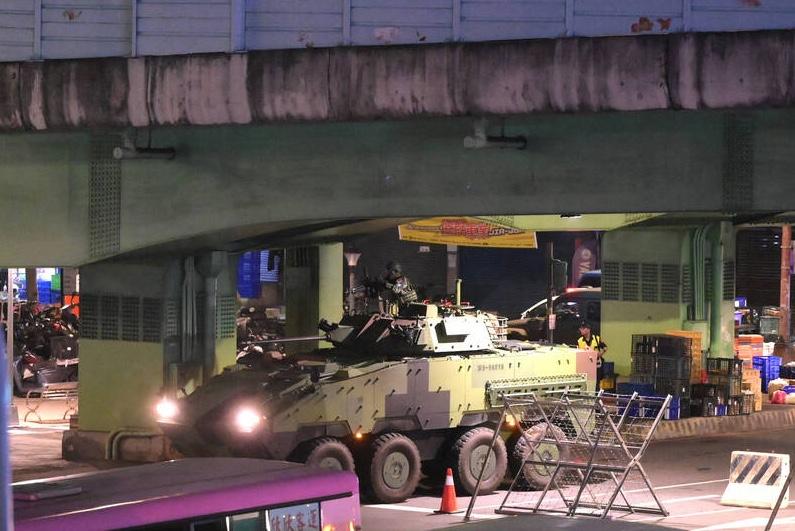The Han Kuang military drills entered their seventh day today, with a focus on prolonged defensive operations.
Units simulated a scenario in which the Chinese People’s Liberation Army (PLA) successfully established beachheads in an invasion of Taiwan, requiring units to block its advance inland toward Taipei.
In Taipei, the 202nd Military Police Command practiced delaying a simulated PLA advance into the city by blocking and fortifying the Wanban Bridge (萬板大橋) that connects New Taipei City’s Banciao District District (板橋) with Taipei’s Wanhua District (萬華), closing the bridge from 11pm yesterday to 6am today.

Photo: Chen Yi-kuan, Taipei Times
The drill began with military police building a four-tier blockade on the bridge within two hours in anticipation of incoming PLA troops.
The temporary 690m-long blockade was made up of roadblocks, civilian buses and barbed wire barricades, as well as newly acquired Hesco bastions: modern, collapsible barriers made of wire mesh and fabric.
Used in Iraq and Afghanistan, these barriers were originally designed for flood control and military fortifications, and have the advantage of accelerating the construction of temporary defenses.

Photo: Wang Yi-sung, Taipei Times
During the drill, military police first used drones to detect the PLA's deployment remotely before simulating opening fire at the Chinese troops.
The second part of the drill simulated PLA troops breaking through three of the four levels of the blockade set up by Taiwan's forces before being fired on by Taiwanese snipers from high points.
The exercise was a continuation of drills from yesterday, during which soldiers practiced using the city’s MRT system to reinforce positions, reach a target area and engage the enemy.
Also in the north, the 269 Mechanized Infantry Brigade carried out defensive exercises against a simulated enemy landing in the Port of Taipei in New Taipei City's Bali District (八里), seeking to hold key strategic positions.
In Lieyu (Little Kinmen, 烈嶼), which lies to the west of Kinmen County's main island, a garrison was deployed to Kinmen Bridge (金門大橋) to guard critical infrastructure and counter an enemy invasion.
Reservists continued to participate in the military exercises and training in various locations around Taiwan.
In Miaoli County, reservists in the 302nd Infantry Brigade continued simulated combat drills and practiced battlefield medical evacuation operations.
Additionally, civilian urban resilience drills started today in central Taiwan, including Taichung, Miaoli County, Nantou County and Changhua County.
They are to continue tomorrow in the south, on Thursday in northern Taiwan and on Friday in the east.

SHIPS, TRAINS AND AUTOMOBILES: The ministry has announced changes to varied transportation industries taking effect soon, with a number of effects for passengers Beginning next month, the post office is canceling signature upon delivery and written inquiry services for international registered small packets in accordance with the new policy of the Universal Postal Union, the Ministry of Transportation and Communications said yesterday. The new policy does not apply to packets that are to be delivered to China, the ministry said. Senders of international registered small packets would receive a NT$10 rebate on postage if the packets are sent from Jan. 1 to March 31, it added. The ministry said that three other policies are also scheduled to take effect next month. International cruise ship operators

NUMBERS IMBALANCE: More than 4 million Taiwanese have visited China this year, while only about half a million Chinese have visited here Beijing has yet to respond to Taiwan’s requests for negotiation over matters related to the recovery of cross-strait tourism, the Tourism Administration said yesterday. Taiwan’s tourism authority issued the statement after Chinese-language daily the China Times reported yesterday that the government’s policy of banning group tours to China does not stop Taiwanese from visiting the country. As of October, more than 4.2 million had traveled to China this year, exceeding last year. Beijing estimated the number of Taiwanese tourists in China could reach 4.5 million this year. By contrast, only 500,000 Chinese tourists are expected in Taiwan, the report said. The report

The Forestry and Nature Conservation Agency yesterday launched a gift box to market honey “certified by a Formosan black bear” in appreciation of a beekeeper’s amicable interaction with a honey-thieving bear. Beekeeper Chih Ming-chen (池明鎮) in January inspected his bee farm in Hualien County’s Jhuosi Township (卓溪) and found that more than 20 beehives had been destroyed and many hives were eaten, with bear droppings and paw prints near the destroyed hives, the agency said. Chih returned to the farm to move the remaining beehives away that evening when he encountered a Formosan black bear only 20m away, the agency said. The bear

Chinese embassy staffers attempted to interrupt an award ceremony of an international tea competition in France when the organizer introduced Taiwan and displayed the Republic of China flag, a Taiwanese tea farmer said in an interview published today. Hsieh Chung-lin (謝忠霖), chief executive of Juxin Tea Factory from Taichung's Lishan (梨山) area, on Dec. 2 attended the Teas of the World International Contest held at the Peruvian embassy in Paris. Hsieh was awarded a special prize for his Huagang Snow Source Tea by the nonprofit Agency for the Valorization of Agricultural Products (AVPA). During the ceremony, two Chinese embassy staffers in attendance